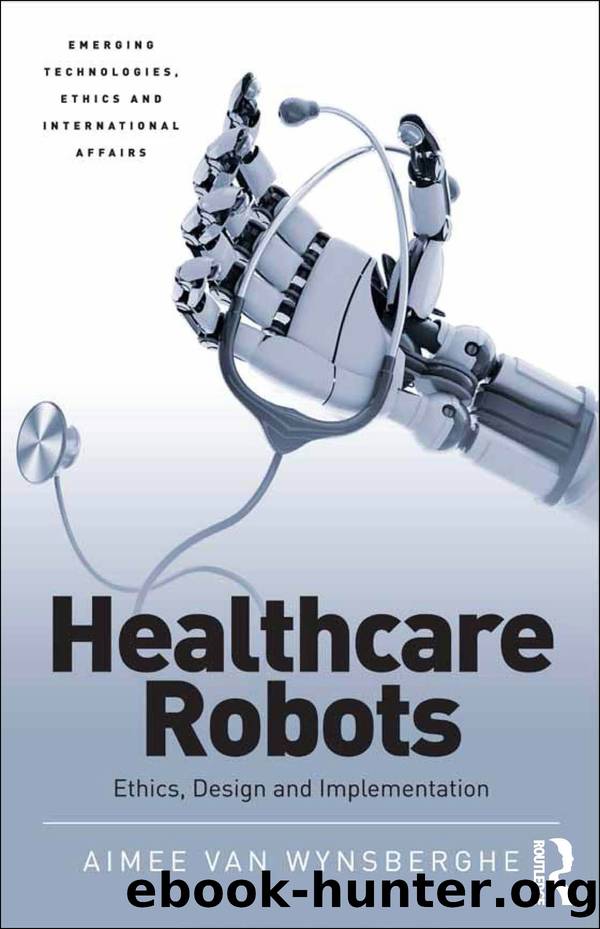Healthcare Robots by Aimee van Wynsberghe

Author:Aimee van Wynsberghe [Wynsberghe, Aimee van]
Language: eng
Format: epub
ISBN: 9781032098609
Google: Xw5nzgEACAAJ
Amazon: B00XCR34XI
Barnesnoble: B00XCR34XI
Goodreads: 25950000
Publisher: Taylor & Francis
Published: 2021-06-30T00:00:00+00:00
Type of Robot as a Component
As we saw in the last chapters, defining and classifying robots is quite complicated given the range of capabilities. Some consider a type of robot according to the domain for which it is used; industrial vs. rehabilitation vs. military vs. search and rescue robots (Veruggio, 2006). For others, types of robots may be in terms of industrial robots vs. service robots. Service robotics are then further distinguished according to personal service robots (e.g. pet robot or automated wheelchair) and professional service robots (e.g. delivery robot in hospitals) (International Federation of Robotics).1 A distinction between industrial and service robot has to do with the amount of human interaction the robot will have and the predictability or structuring of the environment that the robot is working.
For the purposes of the framework discussed here, I classify âtype of robotâ with how the robot will be used among the human actors â how a role and responsibility is delegated to a robot. For example, an enabling robot is one which enables a human to perform an action previously not possible without the robot or, the robot enhances the humanâs performance during a task â the robot and human are working together toward a goal but the human is in control of both him/herself as well as the robot. Thus, the responsibility for accomplishing that role is a shared effort with the robot perceived in an instrumentalist way, as a tool. Robots of this type are: tele-presence robots like the RP7, surgical robots like Intuitive Surgicalâs daVinci®, or exoskeletons like the Hybrid Assistive Limb (HAL).
Next, a replacement robot: this robot is one that fulfils a practice in place of the human. The role of the human and the associated responsibilities are delegated fully to the robot. An example of this type of robot is the RI-MAN autonomous robot for lifting, Secomâs MySpoon automatic feeding robot (when programmed to fulfil all tasks of feeding), or the Sanyo electric bathtub robot that automatically washes and rinses.
Finally, an assistive robot: this is a robot that aids a human in performing an action by providing a portion of the practice without the direct input of a human operator and is thus delegated a partial role and a partial responsibility. This robot differs from an enabling robot in that it does not require consistent input from a human but rather can execute a practice once given its command. Examples of this kind of robot are: the TUG® or HelpMateTM robots used for deliveries in hospitals; the Mitsubishi Wakamaru robot for monitoring and delivering messages; or the Nao robot used for medication reminders (Anderson and Anderson, 2007). In the case of the delivery robots, the role and responsibility of the delivery is shared between the robot and the human deliverer/receiver; however, the robot fulfils many steps without any input from a human user (e.g. navigating through hallways and corridors).
In addition to the type of robot identified, it is important to list the robotâs capabilities as they too play a role in the ethical analysis.
Download
This site does not store any files on its server. We only index and link to content provided by other sites. Please contact the content providers to delete copyright contents if any and email us, we'll remove relevant links or contents immediately.
| Automotive | Engineering |
| Transportation |
Whiskies Galore by Ian Buxton(41525)
Introduction to Aircraft Design (Cambridge Aerospace Series) by John P. Fielding(32885)
Small Unmanned Fixed-wing Aircraft Design by Andrew J. Keane Andras Sobester James P. Scanlan & András Sóbester & James P. Scanlan(32570)
Craft Beer for the Homebrewer by Michael Agnew(17929)
Turbulence by E. J. Noyes(7694)
The Complete Stick Figure Physics Tutorials by Allen Sarah(7135)
Kaplan MCAT General Chemistry Review by Kaplan(6591)
The Thirst by Nesbo Jo(6432)
Bad Blood by John Carreyrou(6271)
Modelling of Convective Heat and Mass Transfer in Rotating Flows by Igor V. Shevchuk(6219)
Learning SQL by Alan Beaulieu(6029)
Weapons of Math Destruction by Cathy O'Neil(5824)
Man-made Catastrophes and Risk Information Concealment by Dmitry Chernov & Didier Sornette(5643)
Digital Minimalism by Cal Newport;(5388)
Life 3.0: Being Human in the Age of Artificial Intelligence by Tegmark Max(5182)
iGen by Jean M. Twenge(5158)
Secrets of Antigravity Propulsion: Tesla, UFOs, and Classified Aerospace Technology by Ph.D. Paul A. Laviolette(4982)
Design of Trajectory Optimization Approach for Space Maneuver Vehicle Skip Entry Problems by Runqi Chai & Al Savvaris & Antonios Tsourdos & Senchun Chai(4837)
Electronic Devices & Circuits by Jacob Millman & Christos C. Halkias(4743)
